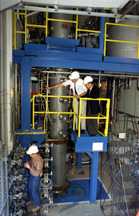 Purdue News
Purdue News
 Purdue News
Purdue News
 A physical law, of course -- and one that a new generation of nuclear reactors will
be exploiting in the coming decades. General Electric's proposed design of a simplified
boiling water reactor, for example, differs from today's commercial reactors by relying on gravity rather than powered mechanical pumps to circulate coolant through the
reactor during normal operations.
A physical law, of course -- and one that a new generation of nuclear reactors will
be exploiting in the coming decades. General Electric's proposed design of a simplified
boiling water reactor, for example, differs from today's commercial reactors by relying on gravity rather than powered mechanical pumps to circulate coolant through the
reactor during normal operations.
"The reactor's passive safety systems also depend on gravity to drain pools of water automatically into the reactor to cool it in case of an accident," says Mamoru Ishii, a Purdue University nuclear engineering professor and world-renowned expert in two-phase flow and the scaling of reactor models.
In this reactor design, says Victor H. Ransom, the head of Purdue's School of Nuclear Engineering, "the only thing operators have to depend on for safety is gravity. You could simply walk away during an accident, and the safety systems would kick in."
Ishii and Ransom lead a research team that designed and is using a one-of-kind facility to test the GE design and obtain data for the U.S. Nuclear Regulatory Commission, which assesses the safety of reactor designs and licenses their construction.
Housed in a hangar at the Purdue airport, the $3.8 million NRC-funded testing facility, called PUMA, for Purdue University Multidimensional Integral Test Assembly, is a scaled-down model of the simplified boiling water reactor and is the only facility in the country based on GE's design.
PUMA simulates conditions within a real reactor but uses electric heating elements instead of the fission reaction. All the components of the model are one-400th the volume and one-fourth the height of the actual reactor. The tallest component is about 22 feet high.
In the proposed simplified boiling water reactor, gravity and differences in density cause water to circulate naturally through the reactor system. The system operates much like a coffee percolator, Ransom says, in which steam and water rise, because of buoyancy, through a central pipe to mix with coffee and then flow back down outside the pipe to pool as liquid coffee in the bottom.
In the reactor, the core where heat is produced is submersed and surrounded by water, much like a central percolator pipe. Above the core is a two-phase mixture of water and steam -- similar to beer foam or soap bubbles on top of liquid -- that is one-tenth as dense as water.
Because of the combination of gravity and the pressure of the denser water surrounding the core, the mixture circulates upward without the need for pumps. At the top of the reactor, the steam and water mixture separates. The water flows back down into the system and the steam goes out to power turbines.
Beginning this month, the Purdue researchers will run 24 tests on the model to reproduce four types of possible accidents, which deal primarily with ruptures in pipes. Purdue students and researchers have installed approximately 400 measuring instruments in the model to determine precisely how the safety systems behave.
The researchers will compare the data they collect with computer predictions about the reactor system's behavior. Ransom, an international expert on reactor safety, has been instrumental during the past 20 years in developing the computer program that will generate those predictions: RELAP5, the NRC's standard tool for assessing the safety of reactor designs.
PUMA will be used for several years by the School of Nuclear Engineering for follow-up tests on design modifications and for instruction and further student research. Ransom already has incorporated the project into an undergraduate course by asking students to design an additional air-cooling system for the reactor.
"This facility is a tremendous opportunity for the university to contribute to the safety of advanced nuclear power plants," he says. "Our students are gaining hands-on experience in the design of cutting-edge energy systems."
According to recent statistics from the Department of Energy, 22 percent of U.S. electricity is generated through nuclear power, second only to coal, which is used to generate 55 percent. Natural gas generates 11 percent, hydroelectric 10 percent, oil 2 percent, and all others combined, including wind, solar and geothermal, comprise 0.2 percent.
In addition to Ransom and Ishii, the principal investigator, other researchers working on the PUMA project are nuclear engineering Professor Martin Lopez-de-Bertodano and mechanical engineering Professor Raymond Viskanta, along with a number of graduate students.
PUMA was constructed under contract to Purdue by a team headed by Phoenix Solutions of Minneapolis.
Sources: Victor H. Ransom, (765) 494-5742; Internet, ransom@ecn.purdue.edu
Mamoru Ishii, (765) 494-4587
Writers: Amanda Siegfried, (765) 494-4709; Internet, amanda_siegfried@purdue.edu
Lisa Tally, (765) 494-9988; Internet, lisa@ecn.purdue.edu
Purdue News Service: (765) 494-2096; e-mail, purduenews@purdue.edu
NOTE TO JOURNALISTS: Color photo of researchers in the reactor simulator is available from Purdue News Service, (765) 494-2096. Ask for the photo called Nuclear Reactor/Ransom or download here.